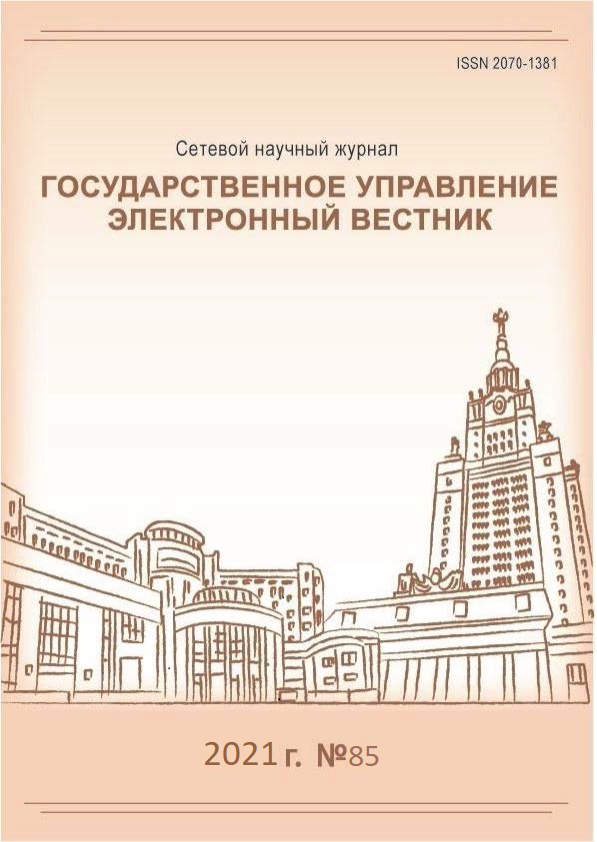Национальные цели и институциональные трансформации: модель стратегического развития
Ключевые слова:
Национальные цели, институциональные изменения, математическая модель, стратегия развития, институциональная матрица, матрица интерактивного планированияАннотация
В статье анализируются институциональные аспекты национальных целей развития Российской Федерации, которые, будучи воплощенными в системе национальных проектов, объективизируют стратегию социально-экономического развития (СЭР) страны. Формулировки целевых показателей позволяют увидеть, что достижение национальных целей предусматривает решение социально-экономических задач совместно с трансформацией ряда экономических, политико-правовых и общественных институтов и институций. Актуальной научной задачей является раскрытие логико-математических, в том числе стохастических, взаимосвязей процессов достижения национальных целей и реформирования институциональной среды. В качестве инструмента исследования в статье используется авторская дескриптивная стохастическая математическая модель стратегического управления СЭР. Для описания взаимосвязи процесса реализации национальных целей с необходимыми институциональными трансформациями вводятся понятия институциональной матрицы и матрицы интерактивного планирования. Показано, что условием успешной реализации стратегии СЭР является осознание ее разработчиками мультипликативно-аддитивной связи стратегических целей и состояния создаваемых и реформируемых институтов с учетом взаимосвязей между ними. Делаются выводы, что непредусмотренное отклонение времени и эффективности реализации каждой из национальных целей от целевых показателей может повлиять на увеличение систематической ошибки реализации стратегии в целом. Кроме того, показано, что реализация стратегии СЭР, построенной на основе системы национальных целей, предполагающих разную динамику достижения, а также необходимость целенаправленных институциональных трансформаций состоят в обеспечении дифференцированной оперативной оценки результатов институциональных изменений и их интерпретации для обоснования целевых показателей очередного этапа стратегии. Успешная реализация стратегии требует адекватного учета степени влияния на достижение каждой национальной цели комплекса институциональных изменений и не допускает стандартного подхода к интерпретации такого влияния.
Библиографические ссылки
Аузан А.А. Развитие и «колея» зависимости // Мировая экономика и международные отношения. 2017. Т. 61. № 10. С. 96–105. DOI: 10.20542/0131-2227-2017-61-10-96-105.
Балацкий Е.В., Екимова Н.А. Эффективность институционального развития России: альтернативная оценка // Terra Economicus. 2015. Т. 13. № 4. С. 31–51. DOI: 10.18522/2073-6606-2015-4-31-51.
Клейнер Г.Б. Гуманистический менеджмент, социальный менеджмент, системный менеджмент путь к менеджменту XXI века // Российский журнал менеджмента. 2018. Т. 16. № 2. С. 231–252. DOI: https://doi.org/10.21638/spbu18.2018.204.
Клейнер Г.Б. Проблемы стратегического государственного планирования и управления в современной России // Проблемы стратегического государственного планирования и управления в современной России. Материалы научного семинара. 2011. Вып. 5(43). М.: Научный эксперт. С. 5–36.
Курзенев В., Матвеенко В. Экономический рост. СПб.: Питер, 2018.
Латова Н.В. Акторы запроса на институциональные перемены в современной России (социально-психологический контекст) // Journal of Institutional Studies. 2019. Т. 11. № 3. С. 119–134. DOI: 10.17835/2076-6297.2019.11.3.119-134.
Норт Д.К. Институты, институциональные изменения и функционирование экономики. М.: Фонд экономической книги «Начала», 1997.
Полтерович В.М. Трансплантация экономических институтов // Экономическая наука современной России. 2001. № 3. С. 24–50.
Тамбовцев В.Л. Устойчивое региональное развитие: актуальные направления институционального анализа // Journal of Institutional Studies. 2019. Т. 11. № 3. С. 104– 118. DOI: 10.17835/2076-6297.2019.11.3.104-118.
Шаститко А.Е. Условия и результаты формирования институтов // Вопросы экономики. 1997. № 3. С. 67–81.
Schotter A. The Economic Theory of Social Institutions. Cambridge: Cambridge University Press, 1981. DOI: https://doi.org/10.1017/CBO9780511983863.
Scott W.R. Institutions and Organizations. 2nd Edition. CA: Sage Publication Inc Books, 2001.
Загрузки
Опубликован
Похожие статьи
- Шпакова Раиса Николаевна, Ожидаемая продолжительность жизни при рождении как целевой показатель в национальных проектах и региональных стратегиях социально-экономического развития , Государственное управление. Электронный вестник: № 84 (2021)
- Россошанская Елена Андреевна, Дорошенко Татьяна Андреевна, Самсонова Наталья Александровна, Ли Елена Львовна, Кузнецов Михаил Евгеньевич, Агешина Елена Юрьевна, Агент-ориентированная демографическая модель Дальнего Востока как инструмент поддержки принятия управленческих решений , Государственное управление. Электронный вестник: № 94 (2022)
- Якимчук Наталья Николаевна, Кузнецова Марина Николаевна, Иванова Марина Вячеславовна, Государственное управление устойчивым развитием территорий: опыт Финляндии и России , Государственное управление. Электронный вестник: № 85 (2021)
- Евтянова Дарья Вячеславовна, Искусственные нейронные сети как инструмент планирования экономического развития , Государственное управление. Электронный вестник: № 84 (2021)
- Соболев Сергей Андреевич, Инструментарий комплексной оценки масштаба социально-экономического развития городских агломераций , Государственное управление. Электронный вестник: № 103 (2024)
- Гвоздева Маргарита Александровна, Баринова Вера Александровна , Ограничения развития устойчивого туризма в России , Государственное управление. Электронный вестник: № 113 (2025)
- Шпакова Раиса Николаевна, Городецкий Дмитрий Игоревич, Перспективы использования технологий искусственного интеллекта для решения проблем регионального стратегического планирования , Государственное управление. Электронный вестник: № 112 (2025)
- Ветренюк Андрей Алексеевич, Типологизация региональной устойчивости в ESG-логике: матричный подход к стратегическим моделям пространственного развития , Государственное управление. Электронный вестник: № 113 (2025)
- Дмитриевская Валерия Юрьевна, Зайцева Татьяна Вячеславовна, Социальная укорененность материальной мотивации персонала организации , Государственное управление. Электронный вестник: № 111 (2025)
- Худяков Владимир Викторович, Мерзлов Игорь Юрьевич, Формирование мероприятий опережающего развития научно-технического потенциала обрабатывающих производств России , Государственное управление. Электронный вестник: № 102 (2024)
Вы также можете начать расширеннвй поиск похожих статей для этой статьи.




